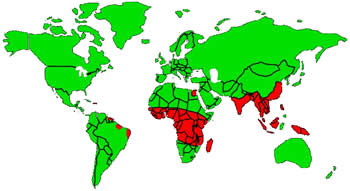Habitat
Brugia malayi lives in multiple
locations during its life. Although the main habitat recognized
for B. malayi is the lymphatic system, the habitat
where it is found is generally swampy or tropical. The parasite
flourishes in freshwater swamp forests in rural locations in
Southeast Asia (Ridley 2011); about 65% of cases are found here.
Thirty percent of cases are in the African region, and the rest
are usually found in other tropical areas (WHO 2014). Sixty five percent of cases found in Southeast Asia are there because it is
mainly rural freshwater swamp forests. Tropical and swamp waters
are a very common breeding location for mosquitoes, giving them
a higher reproduction rate in these areas. A larger number of
infected mosquitoes means more blood meals and more cases of
filariasis.
Above image:
Locations where B. malayi is most
percent of cases found in Southeast Asia are there because it is
mainly rural freshwater swamp forests. Tropical and swamp waters
are a very common breeding location for mosquitoes, giving them
a higher reproduction rate in these areas. A larger number of
infected mosquitoes means more blood meals and more cases of
filariasis.
Above image:
Locations where B. malayi is most
commonly found. Areas where the parasite is
endemic shown in red.
Brugia malayi is very specialized in its habitat
requirements in hosts. In the lymphatic system, the
parasite must be transmitted to host by mosquito, then back to
mosquito in order to continue infecting hosts. The microfilariae
enter the host’s blood during the mosquito’s meal (ADW 2003).
This is why it is always very important to take precautions
when visiting tropical regions! Often times, those who are
infected are unaware that they were even bitten by a mosquito.
 B.
malayi is often found in the same locations as another
blood-borne disease known as malaria. Malaria is an infection
caused by parasitic protozoans in the same regions. Because
malaria is also a blood-borne, mosquito transmitted disease, its
life cycle is very
similar to B. malayi. Malaria causes flu-like
symptoms, and if left untreated, can result in death (CDC 2013).
While Brugia malayi does not cause death, it can impact
quality of life with the physical and mental changes it can make
to the host's body.
B.
malayi is often found in the same locations as another
blood-borne disease known as malaria. Malaria is an infection
caused by parasitic protozoans in the same regions. Because
malaria is also a blood-borne, mosquito transmitted disease, its
life cycle is very
similar to B. malayi. Malaria causes flu-like
symptoms, and if left untreated, can result in death (CDC 2013).
While Brugia malayi does not cause death, it can impact
quality of life with the physical and mental changes it can make
to the host's body.
Left image: Red blood
cell infected with malaria.
Hosts of B. malayi include Mansonia, Aedes, Anopheles,
and Culex, which are all genera containing different species of
mosquitoes used for transmission to definitive hosts. The
definitive hosts include Homo sapiens, domestic cats Felis
silvestris, monkeys, and forest carnivores (ADW 2003). The hosts
that are mosquitoes are used for a home before they are
transported to the definitive host - the larger hosts with
lymphatic systems. The parasite lives here, in these larger
hosts, for most of its life because they feed off of blood and
lymph, which is easily acquired in these locations.

Left image: Left-Wuchereria bancrofti
microfilaria. Center- Female Aedes aegypti. Right-
Brugia malayi microfilaria
While in their habitat in the lymphatic system, Brugia
malayi use their papillae, setae, and aphids for sense. The
papillae are used for copulation, setae are for motion
detection, and aphids are chemoreceptors used to detect
chemicals (ADW 2003). Without these sensory organs, B.
malayi would not stay in the body as long as they do (they
can live for many years!). They would not be able to reproduce,
and the species would go extinct.
The habitat of Brugia malayi is very specialized. They
require two hosts and an
endosymbiont just to keep reproducing
successfully! Without this parasite, millions of people would be
living a much happier and healthier life.
←Classification Home Form and Function→